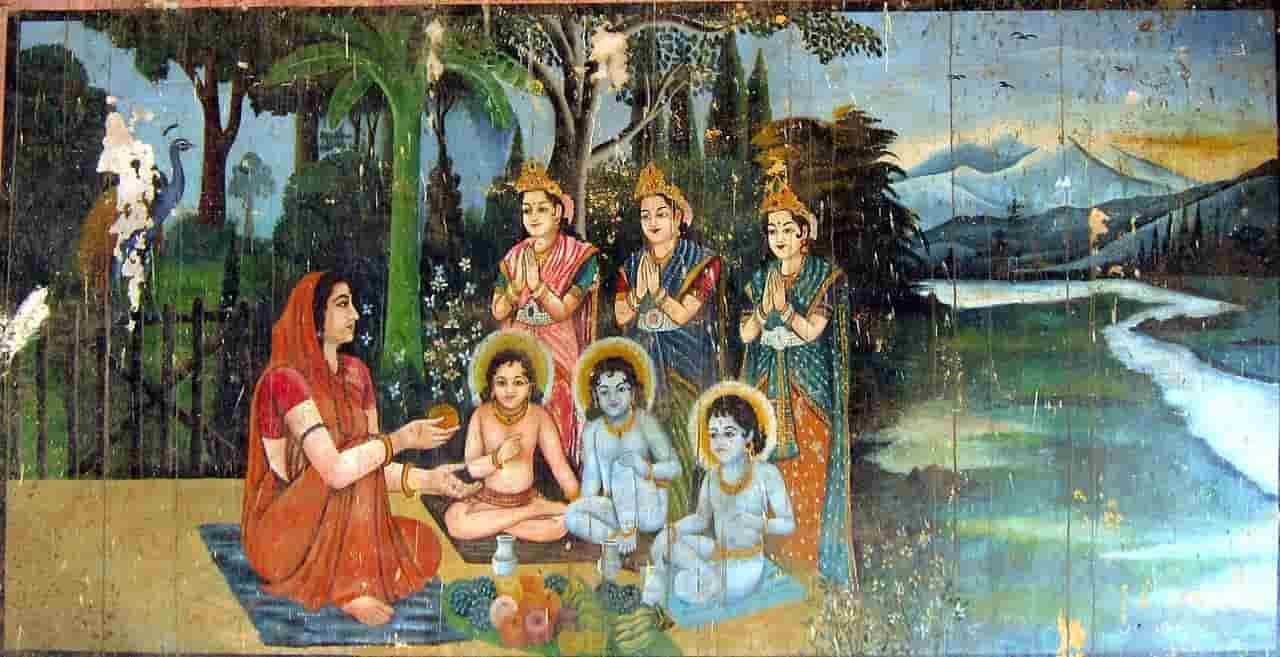Trimurti
Trimurti (three forms) is a term that unites three gods:
1. Brahma, which symbolizes creation.
2. Vishnu who symbolizes conservation.
3. Shiva symbolizes destruction.
Trimurty in Sanskrit: त्रिमूर्ति
The Hindu trinity of the Brahmanical pantheon. The three great gods: Brahma the creator, Vishnu the maintainer and Shiva the destroyer.
This Trinity replaces the Vedas into another, older trinity formed from Agni, Vayu and Surya which symbolizes the sacrificial fire and which is represented by the three-headed body.
Iconographic
From an iconographic point of view, the trinity is represented in the form of three gods perhaps accompanied by their consort or in the form of a single body headed by the heads of three gods.
Colour
Colours are given for guna: black for tamas, red for rajas, and white for sattva. Likewise, the Trimurti is given the elements of earth (Brahma), water (Vishnu) and fire (Shiva).
Concept of Trimurty
The Trinity is a conceptual unity of a three-sided cosmic principle, similar to the Christian Trinity, and not a triad, i.e. not three distinct, related gods, as is known from most polytheistic mythologies. The Christian concept of the Trinity with God the Father, God the Son and God the Holy Spirit differs from Hinduism in its interpretation and philosophy of religion.
As for the guṇa (the three constitutive qualities of material Nature), for example, Brahma is associated with that of passion (Rajas Guna), Vishnu with virtue (Sattva Guna) and Śiva with ignorance (Tamas Guna). The Earth, creator of life, is represented by Brahma; the water, which maintains life, is Vishnu, and the fire which transforms and destroys is Śiva. The sky is Brahma, the sun is Vishnu and the moon is Śiva.
In southern India, where the Scivaites , worshipers of Śiva as the supreme deity, are most widespread, Śiva is believed to embody the triple principle of the entire Trimurti and artistically this is rendered by showing Śiva in pre-eminence and Visnu and Brahma coming out respectively from his left and right flank.
Two important differences with respect to the Trinity of Christianity are the fact that in the latter there is no Trinity of female divinities and the feminine principle is instead internalized in the figure of God , who is both Father and Mother; second difference is that the Trinity is transcendent to creation, but at the same time it can live and take up residence within the man who loves it, while he remains alive, free and aware of this presence within himself.
In Hinduism, in addition to the destination in Paradise or damnation, the soul after death can undergo metempsychosis on earth or even transmigration into animal or vegetable life forms.
Each God of Trimurty has several attributes, a vehicle (or a mount) and many avatars
1. Brahma, or Creation
Among the Hindu gods of the triad, Brahma is the creator. He is also the one who holds the knowledge and the one who reveals the Vedas. He is the personification of the universal spirit, the Absolute.
Represented with four heads (of which only three are visible most often, since they are turned towards the 4 cardinal points), which symbolize the four Vedas.
In his four arms, he can hold a book (symbol of the Vedas), a mala or rosary (which allows time to be measured), a water jug (which represents the cosmic energy which creates the universe), a spoon ( object used in rituals), a lotus, a bow, a scepter. On his left shoulder, he may wear a tiger or black antelope skin. He wears a beard and has a meditative face.
His vehicle is a wild goose (hamsa) which symbolizes knowledge, discernment.
His wife is Saraswati, goddess of knowledge, letters, arts and music.
The color gold symbolizes activity.
Several myths of the Hindu cosmogony are associated with Brahma. According to one of them, “the Supreme Self created the waters where he deposited his seed. From there, germinated a golden egg where was born Brahma who then created the world”.
In Hindu cosmology each cosmic era (kalpa) corresponds to a day of Brahma, which itself corresponds to 4320 million years. Between two kalpas, there is a night of Brahma, which lasts as long as a day. A new creation begins when the God awakens…
With each creation of a universe, Brahma is responsible for putting in order certain pre-existing and eternal elements. In the texts, he is compared to a skilled craftsman who, like a potter, makes a pot appear from clay.
The cult of Brahma is rare, it is forgotten by the Hindu gods. Very few temples in India are dedicated to him (one in Pushkar in Rajasthan and one in Odisha), however his image is often present in temples.
2. Vishnu, preservation
Its role is to keep the world between creation (Brahma) and destruction (Shiva). He is responsible for universal harmony.
Vishnu is always black or dark blue, the color of ether. He is depicted with four or eight arms, in which he holds:
- a wheel (chakra) symbolizing universal energy and spirit.
- a conch (shanka) which evokes water, fertility, genesis. Its resonance can also represent the Aum sound, the cosmic vibrations.
- a golden club (sadha), symbol of his authority.
His vehicle is the Garuda eagle (half-man, half-bird).
His consort is Lakshmi, the goddess of fortune and prosperity.
Read aso: Hinduism | History, Hindu God, Shiva, Mythology, Spirituality and Worship
The most popular representation of Vishnu, shows him stretched out and asleep on the rings of Shesha, the thousand-headed serpent, his wife Lakshmi seated at his feet. In his mystical sleep, he elaborates the world to come. When he wakes up, a lotus stalk comes out of his navel, supporting Brahma, who has the task of creating the universe designed by Vishnu.
Some avatars of Vishnu:
Matsya (the fish), Kurma (the turtle), Varaha (the boar), Narasimha (the lion-man), Vamana (the dwarf), Parashurama, Rama, Krishna (the most popular avatar of Vishnu), Buddha (founder of Buddhism, Hindus consider him the 9th avatar) and Kalkin.
3. Shiva, destruction
Shiva is the most venerated of all the Hindu gods, the ambivalent, the formidable and the beneficent. He destroys the world to create a new, better one.
His eyes are half closed. He opens them for creation and closes them to end the universe and begin a new cycle. Shiva’s forehead is marked with a third eye, a symbol of wisdom. Her long hair, often styled in an ascetic bun, is studded with a crescent moon. From her hair springs the Ganges that the God once received on his head in order to slow down the waves that were in danger of destroying the earth.
Sources: PinterPandai, Britannica, McGill University
Photo credit (main photo): Wmpearl via Wikimedia Commons (Creative Commons CC0 1.0 Universal Public Domain Dedication)
Main photo description: Anasuya Feeding the Hindu Trinity, anonymous painting on the wall of the Krishna-Sudama Temple of Porbandar, India, c. 1907. Anasuya (IAST: Anasūyā, अनसूया “free from envy and jealousy”), also known as Anusuya, was the wife of an ancient rishi (sage) named Atri and daughter of Devahuti and Kardama in the Hindu epics. In the Ramayana, she lived with her husband in a small hermitage on the southern border of the Chitrakuta forest.



